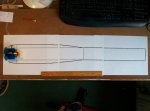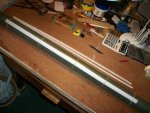quorneng
Master member
The Fieseler Fi103 is much better known as the V-1, the first true 'cruise' missile.
Using Depron as the main structural medium allows planes to be built of a size and weight that would be difficult to achieve in balsa. This in turn enables unusual scale types to fly quite well as I found with by Bachem Ba349 Natter.
The V-1 is actually quite an efficient airframe with a reasonable wing area but was powered by a pulse jet.
The question was could an EDF be placed in a scale pulse jet body fly a V-1 reasonably well?
On the plus side the Argus pulse jet was pretty inefficient so the duct had quite a large diameter for the overall size of the plane, certainly much bigger than a typical turbo jet of the period.

At least with a true circular fuselage section creating the formers is easy!
I chose to size the V-1 round a 55mm EDF that in theory gave 18oz static thrust on a 3s.

So the first task is to build an EDF pulse jet and see just how much thrust was lost to determine if it would be worth going any further.
The first planks go on building round a 55mm diam cardboard tube.

The inner duct complete with formers added to support the outer skin.

The Argus pulse jet complete.

The fan looks an awful long way a way down that duct!

On the plus side with the fan right at the front the inlet should be as efficient as possible.
So far so good.
Using Depron as the main structural medium allows planes to be built of a size and weight that would be difficult to achieve in balsa. This in turn enables unusual scale types to fly quite well as I found with by Bachem Ba349 Natter.
The V-1 is actually quite an efficient airframe with a reasonable wing area but was powered by a pulse jet.
The question was could an EDF be placed in a scale pulse jet body fly a V-1 reasonably well?
On the plus side the Argus pulse jet was pretty inefficient so the duct had quite a large diameter for the overall size of the plane, certainly much bigger than a typical turbo jet of the period.

At least with a true circular fuselage section creating the formers is easy!
I chose to size the V-1 round a 55mm EDF that in theory gave 18oz static thrust on a 3s.

So the first task is to build an EDF pulse jet and see just how much thrust was lost to determine if it would be worth going any further.
The first planks go on building round a 55mm diam cardboard tube.

The inner duct complete with formers added to support the outer skin.

The Argus pulse jet complete.

The fan looks an awful long way a way down that duct!

On the plus side with the fan right at the front the inlet should be as efficient as possible.
So far so good.
Last edited:






















